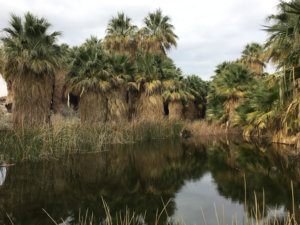Out-Doors: Natural beauty in improbable places

Palm Springs is best known for movie stars, golf courses, fancy resorts and shopping. In quantity! Yet a few weeks back this nature nerd found a bounty of natural wonders in the Coachella Valley, home to Palm Springs, Palm Desert, Rancho Mirage and other tony towns.
Did you know that dates cannot self-pollinate? Archeologists have found 10,000-year-old containers in Mesopotamia that were used to sprinkle pollen onto female date palm flowers. Indio, in the Coachella Valley, is home to the USDA’s Date Station, and the Valley is a leader in American date production. We spent an afternoon at Shields Date Garden in Indio, founded in 1924 and still producing a robust crop of dates. For commercial production male trees are planted in a ratio of one to 48 or 49 female trees. One rain shower during maturation can ruin an entire crop, so huge bunches of maturing dates are covered with paper cones. Dates are harvested by hand with workers climbing ladders permanently affixed to the tall trees—not for the faint of heart—and a mature date palm can produce up to 300 pounds of dates per year.
Most of this region in southwestern California is desert, but in 1853 a government survey party discovered a palm grove near a mineral pool bubbling out of the sand. On New Year’s Eve I set out in search of one of these oases. Driving east from Palm Springs I motored across the sun-baked, featureless sand and past thousands of giant wind turbines before arriving at Coachella Valley Preserve. This 3,709-acre protected parcel sits astride the San Andreas fault, that which triggered the 7.9-magnitude San Francisco earthquake and fire in 1906, killing 3,000 people, and the 6.9-magnitude Loma Prieta earthquake in 1989 that occurred just as the San Francisco Giants prepared to play the Oakland A’s in a World Series game. The latter quake compromised Oakland’s Bay Bridge and brought down San Francisco’s Embarcadero Freeway.
The fault allows underground water to surface, producing both hot and cold springs in the Coachella Valley. At the preserve cold water bubbles to the surface forming swamps and a large pond, both thick with California fan palms. In 1928 the California State Park Commission hired Frederic Law Olmsted to identify preservation targets across the state. In addition to the iconic redwoods Olmsted recognized the importance of palm groves that thrive along the San Andreas Fault.
An hour east of and several thousand feet higher than Palm Springs, Joshua Tree National Park sprawls over nearly 800,000 acres or 1,234 square miles of desert. Two deserts thrive in this vast protected area: the cactus-dotted Colorado Desert and the higher, cooler Mojave Desert, where Joshua trees thrive. A Joshua tree is not a tree at all but a giant yucca, a member of the agave family—think tequila. While the name sounds vaguely biblical, the Joshua tree is not mentioned in the Bible. Legend has it that Mormon pioneers, seeing the limbs of the tree outstretched in supplication, were guided westward. Homesteaders used its limbs and trunks for fencing and corrals, and miners fired steam engines to process ore with it.
The park is also strewn with enormous rock formations and tenement-sized boulders to which rock climbers gravitate from around the globe. On the drizzly day of our late-December visit sirens echoed off the boulders as fire and rescue vehicles gathered near a favorite climbing route. A helicopter hovered beside a sheer rock face with a Stokes basket dangling below it. The following day I searched online for news of an injured climber at Joshua Tree, only to find dozens of stories of climbing falls and deaths in the park in recent years. We satisfied ourselves with several hikes and a panorama at Keys View, elevation 5,185 feet, of the Coachella Valley and the San Andreas Fault sprawling at our feet.
On New Year’s morning, while most of the world slept, we boarded the Palm Springs Aerial Tramway for a 12-minute ride through five climatic zones, from Sonoran desert to Arctic alpine, and up 6,000 feet to the 14,000-acre Mount San Jacinto State Park. Nine inches of fresh powder sparkled in the sun as we walked the Desert View Trail, from which we gazed down at the Coachella Valley, 30 degrees warmer than our 8,516-foot perch.
By midday we were back in that valley, in shorts, for a last nature stop—although we did not visit every natural wonder in the Coachella Valley—Moorten Botanical Garden. Established by the Moorten family in 1934, this private cactus arboretum features desert plants from various desert regions in the west: Texas, Sonoran, Mojave and California. Dozens of rare species shelter in a greenhouse-like “cactaruim.”
All of this before we ventured to Zion National Park and Yellowstone in winter!

